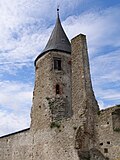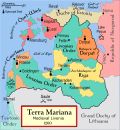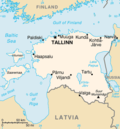Portal:Estonia/Selected article
| This Wikipedia page has been superseded by Portal:Estonia and is retained primarily for historical reference. |
| Note: Article entries are now being transcluded directly on the main portal page. However, this page should be retained for historical reference. |
Usage
The layout design for these subpages is at Portal:Estonia/Selected article/Layout.
- Add a new selected article to the next available subpage.
- Update
"max="to new total for its{{Random portal component}}on the main page.
Selected articles list
Selected article
Portal:Estonia/Selected article/1
Haapsalu Castle (also Haapsalu Episcopal Castle, Estonian: Haapsalu piiskopilinnus) is a castle with cathedral in Haapsalu, western Estonia. It was founded in the thirteenth century to be a center for Bishopric of Ösel-Wiek. When there is a full moon in the month of August, it is said that an image of a maiden, the White Lady, appears on the inner wall of the chapel.In 1228, the Archbishop of Riga, Albert of Riga formed a new diocese consisting of Läänemaa, Saaremaa and Hiiumaa and designated Gottfried, an abbot of Dünamünde Cistercian monastery, as the bishop. The bishopric was created as a state of Holy Roman Empire on 1 October 1228, by Henry, King of the Romans. Papal legate Wilhelm of Modena fixed these borders permanently in 1234. The first residence of the Bishopric of Ösel-Wiek was located in Lihula Castle, where with the help of the Livonian Brothers of the Sword, a stronghold was built of stone. In an attempt to avoid conflicts with the influential Order, the Bishop transferred the diocese's residence to Perona, where it was burned by Lithuanians ten years later. A new center for the diocese was chosen in Haapsalu, where an Episcopal stronghold and cathedral were started. Building of the castle went on for three centuries.
Portal:Estonia/Selected article/2
The Baltic Sea is located in Northern Europe, from 53°N to 66°N latitude and from 20°E to 26°E longitude. It is bounded by the Scandinavian Peninsula, the mainland of Northern Europe, Eastern Europe and Central Europe, and the Danish islands. It drains into the Kattegat by way of the Öresund, the Great Belt and the Little Belt. The Kattegat continues through the Skagerrak into the North Sea and the Atlantic Ocean. The Baltic Sea is linked to the White Sea by the White Sea Canal and to the North Sea by the Kiel Canal.The origin of the name is speculative. The first to mention "Mare Balticum" was Adam of Bremen in the 11th century. He may have alluded to the mythical North European island of Baltia mentioned by Xenophon. Another possibly is connected to the Germanic word belt, a name used for some of the Danish straits, while others claim it to be derived from Latin balteus (belt).
The Baltic sea is about 1610 km (1000 miles) long, an average of 193 km (120 mi) wide, and an average of 55 m (180 ft, 30 fathoms) deep. The maximum depth is 459 m (1506 ft), on the Swedish side of the center. The surface area is about 377,000 km² (145,522 sq mi) and the volume is about 21,000 cubic km (3129 cubic miles). The periphery amounts to about 8000 km (4968 miles) of coastline.
Portal:Estonia/Selected article/3
Tallinn (recent historical name: Reval) is the capital city and main seaport of Estonia. It is located on Estonia's north coast to the Baltic Sea, 80 kilometres south of Helsinki. Already in 1154 Tallinn was marked on the world map of the Arab cartographer al-Idrisi.The largest lake in Tallinn is Lake Ülemiste (covers 9,6 km²). It is the main source of the city's drinking water. Unlike many of the large towns, the only significant river in Tallinn is located in Pirita (city district counted as a suburb). The river valley is a protected area because of its natural beauty. During the 1980 Summer Olympics a regatta was held at Pirita. Many buildings, like the hotel "Olümpia", the new Main Post Office building, and the Regatta Center, were built for the Olympics.
The main attractions are in the two old towns (Lower Town and Toompea) which are both easily explored on foot. Toompea was once the home of the nobility and bishops of Estonia, occupying an easily defensible site overlooking the surrounding districts. The major attractions are the walls and various bastions, the Russian Orthodox Alexander Nevsky Cathedral (built during the period of Russification by the Tsarist Russian government) and the Lutheran Cathedral (Toomkirik).
Portal:Estonia/Selected article/4
The Great Northern War was the war fought between a coalition of Russia, Denmark-Norway, and Saxony-Poland (from 1715 also Prussia and Hanover) on one side and Sweden with some help from the Ottoman Empire on the other side from 1700 to 1721. It started by a coordinated attack on Sweden by the coalition in 1700, and ended in 1721 with the conclusion of the Treaty of Nystad, and the Stockholm treaties. A result of the war was the end of the Swedish Empire. Russia supplanted Sweden as the dominant Power on the Baltic Sea and became a major player in European politics.Portal:Estonia/Selected article/5 Estonian mythology is a complex of myths belonging to the folk heritage of Estonians.
Not much is known about authentic pre-Christian Estonian mythology, as it was a purely oral tradition and systematic recording of folk heritage started in only in the 19th century, by which time the old myths were all but extinct.
One should also have in mind that in the different development stages of the Estonian mythology it would be more correct to talk about Baltic-Finnic or even Finno-Ugric mythology. The social organization of these tribes was rather homogenous; there was no organized religion, no professional priests, no scripture and indeed no written tradition at all. Similarly there was no complex pantheon or advanced system of myths.
This was perceived as a shortcoming by 19th century Estonian and Baltic-German literati who started to create a "proper" mythological basis for an emerging nation, following the Herderian lines of national romanticism. Today it is difficult to tell how much of Estonian mythology as we know it today was actually constructed in the 19th and early 20th century. One should also note that some constructed elements are loans from Finnish mythology and may date back to the common Baltic-Finnic heritage.
Portal:Estonia/Selected article/6
Tartu (historical name: Dorpat) is the second largest city of Estonia, with a population of 101,297 (as of 2004) and an area of 38.8 km². In contrast to Estonia's political and financial capital Tallinn, Tartu is often considered the intellectual and cultural centre, especially since it is home to Estonia's oldest and most renowned university. Situated 186 km southeast of Tallinn, Tartu is the centre of Southern Estonia. The Emajõgi River, which connects the two largest lakes of Estonia, crosses the city for a length of 10 km.Archaeological evidence of first permanent settlement on the site of modern Tartu dates to as early as the 5th century AD. By the 7th century, the local inhabitants had built a wooden fortification on the east side of Toome Hill (Toomemägi).
The first documented record of the place was made in 1030 by chroniclers of Kievan Rus. Yaroslav the Wise, Prince of Kiev, raided Tartu that year, built his own fort there, and named it Yuryev (literally "Yury's" - Yury being Yaroslav's Christian name). Kievan rulers then collected tribute from the surrounding ancient Estonian county of Ugaunia, possibly until 1061, when, according to chronicles, Yurev was burned down by another tribe of Chudes (Sosols).
Portal:Estonia/Selected article/7
Estonia was a dominion of Denmark during Middle Ages. Between 1206 and 1645 Denmark for several periods of time either held claims to, or ruled over, parts of present-day Estonia.Denmark rose as a great military and merchant power in the 12th century. It had an interest to end the occasional Estonian and Couronian pirate attacks that threatened its Baltic trade. Danish fleets made attacks against Estonia in 1170, 1194, and 1197. In 1206 King Valdemar II and archbishop Andreas Sunonis made a raid to Ösel (Saaremaa) island. The islanders were forced to submit and the Danes built a fortress there, but they found no volunteers to man it. They burned it down themselves and left the island. However, they laid a claim to Estonia as their possession, which was recognized by the pope.
In 1219 Valdemar gathered a fleet of hundreds of ships against the Estonians, led by the archbishop, bishops and the army of Rugians under their prince Wizlav. They landed in Lyndanisse (Tallinn) harbor in the province of Revelia (Revala, Rävälä, later merged into Harria province) in northern Estonia. According to a legend, the first ever flag of Denmark fell from sky and helped the Danes to win the battle against Revelians and Harrians. The date of the battle, June 15th, is the annual holiday of Valdemarsdag in present Denmark.
Portal:Estonia/Selected article/8
Tartu County (Estonian: Tartu maakond), or Tartumaa, is one of 15 counties of Estonia. It is located in eastern Estonia bordering to Põlva County, Valga County, Viljandi County and Jõgeva County. The area of Tartu County is 2,992.74 km², which covers 6.9% of the territory of Estonia. The population of the county is 148,992, which is 11.0% of the population of Estonia. The city of Tartu is the centre of the county located at a distance of 186 km from Tallinn. Tartu County is divided into 22 local governments — 3 urban and 19 rural municipalities.Archaeological findings suggest that people first inhabited the territory of the current Tartu County about 5000 years ago. City of Tartu was first mentioned in historical records in 1030, then a site of a wooden stronghold. In 1224, after the conquest of the stronghold by the German invaders, Tartu became the capital of a diocese, stretching from Northern Estonia to Latvia. Since the 13th century, Tartu belonged to the Hanseatic League, and the town became a well-known trade centre in the Baltic Sea region.
Portal:Estonia/Selected article/9 Estonian (; IPA: [ˈeːs.ti ˈkeːl]) is the official language of Estonia, spoken by about 1.1 million people in Estonia and by some ten thousand in various émigré communities. It is a Finno-Ugric language and is closely related to Finnish.
One distinctive feature that has caused a great amount of interest in linguists is that Estonian has what is traditionally seen as three degrees of phoneme length: short, long, and "overlong", such that IPA /toto/, /toːto/ and /toːˑto/ are distinct, as are /toto/, /totːo/, and /totːˑo/. In actuality, the distinction isn't purely in the phoneme length, and the underlying phonological mechanism is still disputed.
Another feature that sets Estonian apart from most languages is the vowel õ ([ɤ]), a close-mid near-back unrounded vowel, which is farther back than the schwa ([ə]), but fronter than [o].
Portal:Estonia/Selected article/10 The Molotov–Ribbentrop Pact, also known as the Hitler-Stalin Pact or German-Soviet Non-aggression Pact or Nazi-Soviet Pact and formally known as the Treaty of Non-aggression between Germany and the Union of Soviet Socialist Republics, was a non-aggression treaty between the German Third Reich and the Soviet Union. It was signed in Moscow on August 23, 1939, by the Soviet foreign minister Vyacheslav Molotov and the German foreign minister Joachim von Ribbentrop. The mutual non-aggression treaty lasted until Operation Barbarossa of June 22, 1941, when Nazi Germany invaded the Soviet Union.
Although officially labeled a "non-aggression treaty", the pact included a secret protocol, in which the independent countries of Finland, Estonia, Latvia, Lithuania, Poland and Romania were divided into spheres of interest of the parties. The secret protocol explicitly assumed "territorial and political rearrangements" in the areas of these countries. Subsequently all the mentioned countries were invaded, occupied or forced to cede part of their territory by either the Soviet Union, Germany, or both.
Portal:Estonia/Selected article/11
Geography of Estonia, between 57.3 and 59.5 latitude and 21.5 and 28.1 longitude, Estonia lies on the eastern shores of the Baltic Sea on the level northwestern part of the rising east European platform. It borders the Gulf of Finland, between Latvia and Russia. Average elevation reaches only 50m (160 ft.).The climate resembles that of New England, maritime, wet, with moderate winters and cool summers. Oil shale and limestone deposits, along with forests which cover 47% of the land, play key economic roles in this generally resource-poor country. Estonia boasts over 1,500 lakes, numerous bogs, and 3,794 kilometers of coastline marked by numerous bays, straits, and inlets. Tallinn's Muuga port offers one of Europe's finest warm-water harbor facilities.
Estonia's strategic location has precipitated many wars that were fought on its territory between other rival powers at its expense. In 1944, under Soviet occupation, the Jaanilinn and Petseri regions were annexed to Russian SFSR territory. The legal status of these territories, the border question, remains unsettled between Republic of Estonia and Russian Federation, successor of Soviet Union.
Portal:Estonia/Selected article/12
Saaremaa is the largest island (2673 km²) belonging to Estonia. It is located in the Baltic Sea, south of Hiiumaa island, and belongs to the west Estonian archipelago. The capital of Saaremaa is Kuressaare, which has about 16,000 inhabitants; the whole island has about 40,000 inhabitants.Saaremaa is the main island of Saare County, called Saaremaa or Saare maakond in Estonian, and in Finnish Saarenmaa — literally isle's land. The Swedish and German name of the island is Ösel, and the Danish is Øsel.
According to archeological finds, the territory of Saaremaa has been inhabited for at least five thousand years. In old Scandinavian sagas, Saaremaa is called Eysysla which means exactly the same as the name of the island in Estonian: the district (land) of island. This is the origin of the island's name in German and Swedish, Ösel, Danish, Øsel, and in Latin Osilia. The name Eysysla appears sometimes together with Adalsysla, 'the big land', perhaps 'Suuremaa' or 'Suur Maa' in Estonian which refers to mainland Estonia. Sagas talk about numerous skirmishes between islanders and Vikings. Saaremaa was the wealthiest county of ancient Estonia and the home of notorious Estonian pirates, sometimes called the Eastern Vikings. The Chronicle of Henry of Livonia describes a fleet of sixteen ships and five hundred Osilians ravaging the area that is now southern Sweden, then belonging to Denmark.
Portal:Estonia/Selected article/13
Oil shale is a general term applied to a fine-grained sedimentary rock containing significant traces of kerogen (a solid mixture of organic chemical compounds) that have not been buried for sufficient time to produce conventional fossil fuels. When heated to a sufficiently high temperature a vapor is driven off which can be distilled (retorted) to yield a petroleum-like 'shale oil' - a form of unconventional oil - and combustible 'shale gas'.The kerogen in oil shale can be converted to oil through the chemical process of pyrolysis. Oil shale can also be burnt directly as a low-grade fuel for power generation and heating, and be used as a raw material in the chemical and construction materials industries. Currently oil shales are used commercially for oil production in Estonia, Brazil and China, for power generation in Estonia, China, Israel and Germany, for cement production in Estonia, Germany and China, and for chemical industry in Estonia and Russia.
Portal:Estonia/Selected article/14 The Prime Minister of Estonia (Estonian: Eesti Vabariigi Peaminister) is the head of government of the Republic of Estonia. The prime minister is chosen by the President and conferred by Parliament. This is usually the leader of the largest party or coalition in the Parliament. The current Prime Minister is Andrus Ansip, who took office on 12 April 2005, representing the coalition of Estonian Reform Party (Eesti Reformierakond), the Estonian Centre Party (Eesti Keskerakond), and the People's Union of Estonia (Eestimaa Rahvaliit).
The activity of the government is directed by the Prime Minister, who is the actual political head of state. He does not head any specific ministry, but is, in accordance with the constitution, the supervisor of the work of the government. The Prime Minister’s significance and role in the government and his relations with other ministries often depend on the position of the party led by the prime minister in vis-à-vis the coalition partners, and on how much influence the prime minister possesses within his own party. If the prime minister has a strong position within his party, and the government is made up solely of representatives of that party, he can enjoy considerable authority. In all crucial national questions, however, the final word rests with Riigikogu as the legislative power.










